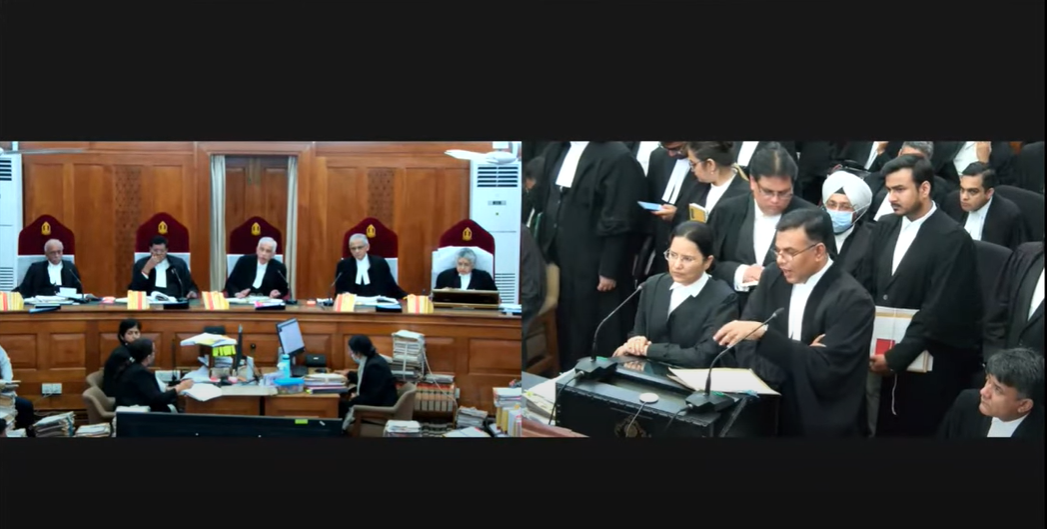 Dispatches
DispatchesIndian law students are reporting for JURIST on law-related developments in and affecting India. Here Apoorv Vats, a second-year student at NALSAR University of Law, files from Hyderabad on the inauguration of full video livestreaming from the Supreme Court of India.
On Tuesday September 27th the Supreme Court of India commenced livestreaming of court proceedings. The live stream of the three Constitution benches was done through the YouTube channel of the National Informatics Centre and garnered some 800,000 views. The decision to livestream was made unanimously at a full court meeting last week consisting of all sitting judges of the Supreme Court, presided by the Chief Justice of India, Hon’ble Justice UU Lalit.
Currently, the livestreaming facility is limited to proceedings of Constitution benches. These benches are composed of five or more judges to decide on substantial questions of law involving interpretation of India’s Constitution. Given the significance of such decisions, the move was felt imperative to benefit the citizenry. However, the Supreme Court is not the forerunner in this regard in the country as a whole. As many as six state High Courts already initiated the practice of livestreaming court proceedings across India during the COVID lockdown.
Livestreaming builds on the conception of an open court and greatly enhances a court’s transparency and accessibility. Undoubtedly, its significance cannot be understated, and it is bound to have both positive and negative consequences on the apex court’s functioning. The judiciary, whose interaction with the public has been limited, will now come into the spotlight. This development is even more consequential in light of the upcoming and ongoing Constitutional bench cases like the challenges to the Sabrimala verdict, Citizenship (Amendment) Act of 2019, and the abrogation of Article 370, as well as ascertaining Reservation for the Economically Weaker Section (EWS).
It is also noteworthy that the Supreme Court of India has been clear on its stance on livestreaming its own proceedings since 2018. In Swapnil Tripathy v. Supreme Court, the court proposed a pilot project wherein a select category of cases of constitutional significance would be live streamed. To quote the Supreme Court:
Sunlight is the best disinfectant. Live-streaming as an extension of the principle of open courts will ensure that the interface between a court hearing with virtual reality will result in the dissemination of information in the widest possible sense, imparting transparency, and accountability to the judicial process.
It was ruled in the same case that livestreaming is in furtherance of Article 21 and Article 19(1)(a) of the Indian Constitution, which guarantee the “right to access justice” as a subset of the fundamental right to life, and the “right to information” as a subset of the fundamental right to freedom of speech and expression, respectively. However, this judgment remained unheeded until the COVID pandemic forced the courts to function virtually, and some of the High Courts in the country started live streaming their proceedings.
Subsequently, in September 2020, a parliamentary standing committee tabled its 103rd report on “Functioning of Virtual Courts / Court Proceedings through Video Conferencing.” The report underscored the role of livestreaming to “promote openness and transparency which would reinforce public faith in the judicial system.” Later, in June 2021, the Supreme Court drafted the “Model Rules for Live-Streaming and Recording of Court Proceedings” to regulate the live streaming of court proceedings. These rules excluded matrimonial disputes, cases concerning sexual offences and gender-based violence from livestreaming.
It has been repeatedly emphasized by legal activists and practitioners alike that live stream of court proceedings will increase public engagement with the judiciary. As per Indira Jaising, Senior Advocate , “There is no substitute for first-hand knowledge, especially in the era of what has come to be known as fake news and hence, there is an urgent need for real-time information.” Lawyers, law students, and journalists will get an opportunity to dissect the intricacies of the arguments and judgments as and when they are being pronounced. It is also argued that similar to India’s Parliament, which is live streamed, the Supreme Court also deliberates on issues of national importance, and the general public being the primary stakeholders, should have real-time access to its proceedings.
However, against the backdrop of the merits of live streaming and celebration amongst legal activists, many have raised concerns over its implications. In an era of sensationalism, judges and lawyers are likely to alter their behaviour subconsciously. Judges may refrain from making unpopular statements or questions, fearing social media backlash. On the other hand, lawyers may choose to play to the gallery and convince the public at large instead of the judges. Further, lately, there has been a tendency to give undue importance to the individual oral observation of judges rather than the full reasoning/dictum of the judgment. To add to that, the circulation of short clips taken out of context may spur more “fake news” and propaganda on social media. Arguably, technological and legal safeguards are required against the possibility of such informational anarchy.
Chief Justice of India Justice UU Lalit has had a a short yet already immensely significant tenure with his approach towards judicial administration. Before his appointment, Justice UU Lalit stated that he aimed to get “maximum output through limited resources.” With the commencement of livestreaming of SCI proceedings, disposal of over 5,000 cases in his first 13 days, and listing of 25 Constitution bench cases starting from his term, Justice Lalit seems to have stood by his promise.

